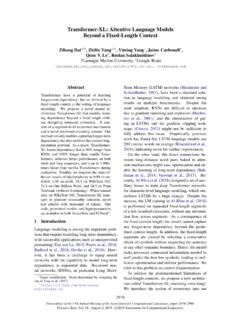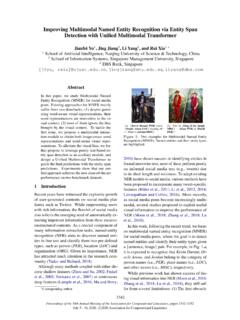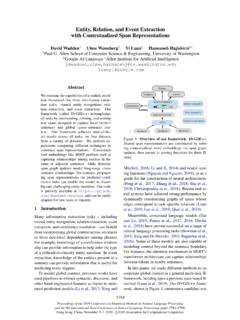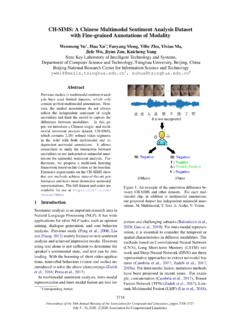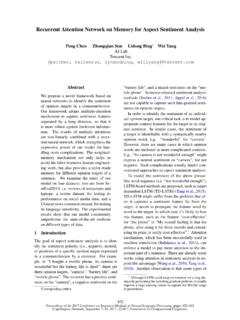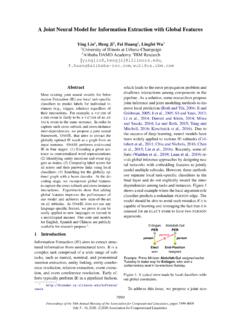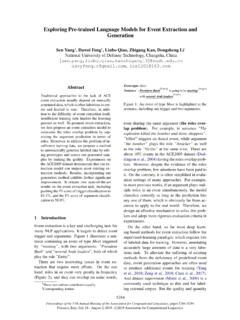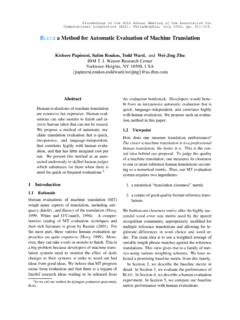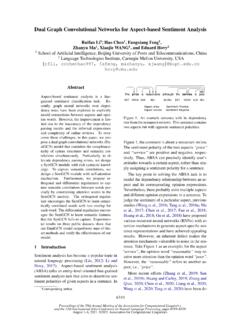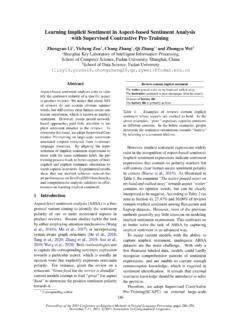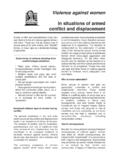Transcription of Conceptual Captions: A Cleaned, Hypernymed, Image Alt-text ...
1 Proceedings of the 56th Annual Meeting of the Association for Computational Linguistics (Long Papers), pages 2556 2565 Melbourne, Australia, July 15 - 20, 2018 Association for Computational Linguistics2556 Conceptual Captions: A Cleaned, Hypernymed, Image Alt-text DatasetFor Automatic Image CaptioningPiyush Sharma, Nan Ding, Sebastian Goodman, Radu SoricutGoogle AIVenice, CA present a new dataset of Image captionannotations, Conceptual Captions, whichcontains an order of magnitude more im-ages than the MS-COCO dataset (Lin et al.,2014) and represents a wider variety ofboth images and Image caption styles. Weachieve this by extracting and filtering im-age caption annotations from billions ofwebpages. We also present quantitativeevaluations of a number of Image cap-tioning models and show that a modelarchitecture based on Inception-ResNet-v2 (Szegedy et al.)
2 , 2016) for Image -featureextraction and Transformer (Vaswani et al.,2017) for sequence modeling achieves thebest performance when trained on the Con-ceptual Captions IntroductionAutomatic Image description is the task of pro-ducing a natural-language utterance (usually a sen-tence) which correctly reflects the visual contentof an Image . This task has seen an explosion inproposed solutions based on deep learning architec-tures (Bengio, 2009), starting with the winners ofthe 2015 COCO challenge (Vinyals et al., 2015a;Fang et al., 2015), and continuing with a variety ofimprovements (see Bernardi et al. (2016) for areview). Practical applications of automatic imagedescription systems include leveraging descriptionsfor Image indexing or retrieval, and helping thosewith visual impairments by transforming visual sig-nals into information that can be communicated viatext-to-speech technology.
3 The scientific challengeis seen as aligning, exploiting, and pushing furtherthe latest improvements at the intersection of Com-puter Vision and Natural Language : A Pakistani worker helpsto clear the debris from the Taj Ma-hal Hotel November 7, 2005 in Bal-akot, Captions: a workerhelps to clear the : Musician Justin Timber-lake performs at the 2017 Pilgrim-age Music & Cultural Festival onSeptember 23, 2017 in Franklin, Captions: pop artistperforms at the festival in a 1: Examples of images and Image descrip-tions from the Conceptual Captions dataset; westart from existing Alt-text descriptions, and auto-matically process them into Conceptual Captionswith a balance of cleanliness, informativeness, flu-ency, and are two main categories of advances re-sponsible for increased interest in this task.
4 Thefirst is the availability of large amounts of anno-tated data. Relevant datasets include the ImageNetdataset (Deng et al., 2009), with over 14 millionimages and 1 million bounding-box annotations,and the MS-COCO dataset (Lin et al., 2014), with120,000 images and 5-way Image -caption anno-tations. The second is the availability of power-ful modeling mechanisms such as modern Con-volutional Neural Networks ( Krizhevsky et al.(2012)), which are capable of converting Image pix-els into high-level features with no manual this paper, we make contributions to boththe data and modeling , wepresent a new dataset of caption annotations , Conceptual Captions (Fig. 1), which has an or-der of magnitude more images than the COCO Conceptual Captions consists of Image ,description pairs.
5 In contrast withthe curated style of the COCO images, Concep-tual Captions images and their raw descriptionsare harvested from the web, and therefore repre-sent a wider variety of styles. The raw descriptionsare harvested from the Alt-text HTML attribute associated with web images. We developed an au-tomatic pipeline (Fig. 2) that extracts, filters, andtransforms candidate Image /caption pairs, with thegoal of achieving a balance of cleanliness, informa-tiveness, fluency, and learnability of the a contribution to the modeling category, weevaluate several Image -captioning models. Basedon the findings of Huang et al. (2016), we useInception-ResNet-v2 (Szegedy et al., 2016) forimage-feature extraction, which confers optimiza-tion benefits via residual connections and com-putationally efficient Inception units.
6 For cap-tion generation, we use both RNN-based (Hochre-iter and Schmidhuber, 1997) and Transformer-based (Vaswani et al., 2017) models. Our resultsindicate that Transformer-based models achievehigher output accuracy; combined with the reportsof Vaswani et al. (2017) regarding the reduced num-ber of parameters and FLOPs required for training& serving (compared with RNNs), models such asT2T8x8(Section 4) push forward the performanceon Image -captioning and deserve further Related WorkAutomatic Image captioning has a long history (Ho-dosh et al., 2013; Donahue et al., 2014; Karpa-thy and Fei-Fei, 2015; Kiros et al., 2015). Ithas accelerated with the success of Deep Neu-ral Networks (Bengio, 2009) and the availabilityof annotated data as offered by datasets such asFlickr30K (Young et al.)
7 , 2014) and MS-COCO (Linet al., 2014).The COCO dataset is not large (order of106im-ages), given the training needs of DNNs. In spiteof that, it has been very popular, in part becauseit offers annotations for images with non-iconicviews, or non-canonical perspectives of objects,and therefore reflects the composition of everydayscenes (the same is true about Flickr30K (Younget al., 2014)). COCO annotations category label-ing, instance spotting, and instance segmentation are done for all objects in an Image , including those the background, in a cluttered environment, orpartially occluded. Its images are also annotatedwith captions, sentences produced by human an-notators to reflect the visual content of the imagesin terms of objects and their actions or large number of DNN models for Image cap-tion generation have been trained and evaluatedusing COCO captions (Vinyals et al.
8 , 2015a; Fanget al., 2015; Xu et al., 2015; Ranzato et al., 2015;Yang et al., 2016; Liu et al., 2017; Ding and Soricut,2017). These models are inspired by sequence-to-sequence models (Sutskever et al., 2014; Bahdanauet al., 2015) but use CNN-based encodings in-stead of RNNs (Hochreiter and Schmidhuber, 1997;Chung et al., 2014). Recently, the Transformer ar-chitecture (Vaswani et al., 2017) has been shownto be a viable alternative to RNNs (and CNNs) forsequence modeling. In this work, we evaluate theimpact of the Conceptual Captions dataset on theimage captioning task using models that combineCNN, RNN, and Transformer related to this work is the Pinterest imageand sentence-description dataset (Mao et al.
9 , 2016).It is a large dataset (order of108examples), but itstext descriptions do not strictly reflect the visualcontent of the associated Image , and therefore can-not be used directly for training Conceptual Captions Dataset CreationThe Conceptual Captions dataset is programmat-ically created using a Flume (Chambers et al.,2010) pipeline. This pipeline processes billionsof Internet webpages in parallel. From these web-pages, it extracts, filters, and processes candidate Image ,caption pairs. The filtering and process-ing steps are described in detail in the FilteringThe first filtering stage, Image -based filtering, discards images based onencoding format, size, aspect ratio, and offensivecontent. It only keeps JPEG images where bothdimensions are greater than 400 pixels, and theratio of larger to smaller dimension is no more than2.
10 It excludes images that trigger pornography orprofanity detectors. These filters discard more than65% of the FilteringThe second filtering stage,text-based filtering, harvests Alt-text from HTML webpages. Alt-text generally accompanies images,2558[ Alt-text not processed:undesired Image format, aspect ratio or size] Alt-text Ferrari dice The meaning of life Demi Lovato wearing a black Ester Abner Spring 2018 gown and Stuart Weitzman sandals at the 2017 American Music Awards Image [ Alt-text discarded]CAPTION pop rock artist wearing a black gown and sandals at awards [ Alt-text discarded:Text does not contain ][ Alt-text discarded:No text vs. Image -object overlap] Image FilteringText FilteringImg/Text FilteringText TransformPIPELINEIMAGEIMAGEIMAGEF igure 2: Conceptual Captions pipeline steps with examples and final intends to describe the nature or the content ofthe Image .
